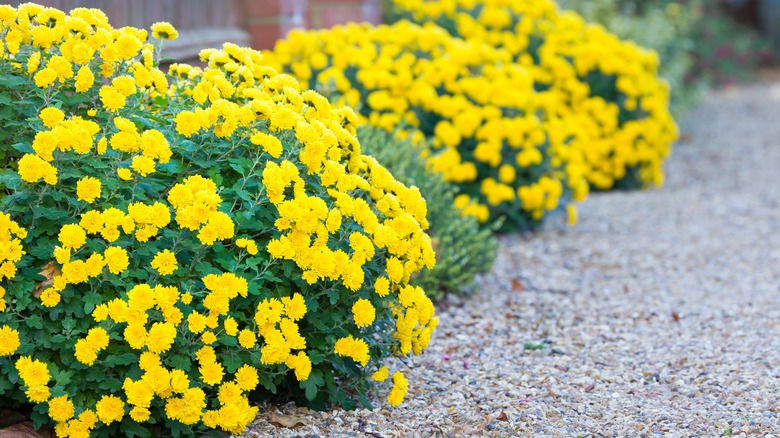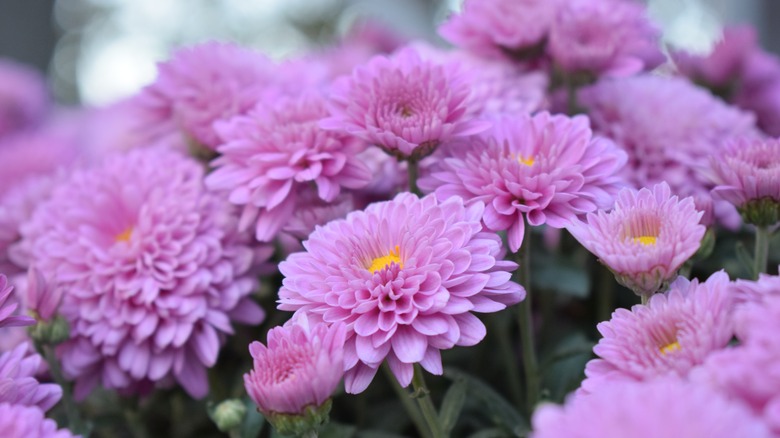Tricks For Planting Your Potted Mums So They'll Come Back Each Year
Chrysanthemums are a sure sign of late summer, lending their bright colors to displays and prolonging the beauty of your garden well into autumn. But even though many people treat mums like annuals — only growing them in containers — they can easily be transplanted into your garden and become perennials that return each year. There are some useful tips for prolonging the life of these attractive, easy-care flowers. The two main things to remember about mums are to choose small plants instead of large ones and plant them as early as possible.
Mums are such a beloved choice for autumn decor some people are not aware that these colorful flowers are not annuals. This is why one often sees heaps of dried flowers dumped in the trash or on compost heaps in the late autumn after a hard frost has killed the flowers. However, mums planted in the ground will come back. They'll provide years of late-season beauty, if you plant your mums properly.
If you want to try growing mums as perennials, you can acquire small potted plants via mail-order sites in the spring. This will give them plenty of time to get acclimated to weather conditions, and they will bloom starting in late summer and continue through the fall. Mail-order companies will usually offer a wider selection of mums than many nurseries. But you can also plant potted nursery mums; these are usually placed out for sale starting in September.
Why size matters when you're planting mums
If you normally pick out some big bushel basket mums to decorate your porch, go ahead, but for planting, you want to get the smallest mums available, usually in a 4 to 6-inch pot. If this size isn't available, an 8 to 10-inch pot will also work. It's not so much the size of the pot or even the roots that matter. It's the size of the plant and how many stems it has.
Commercial mums are trimmed and pinched back starting early in the season to give them numerous blooms. But doing this can sometimes weaken a young plant because it takes a lot of energy to produce so many flowers. The bushel basket mums are a good example of this. They're aggressively pinched and shaped, using up a lot of the plant's energy, and this is one reason that planting bushel mums usually doesn't lead to a perennial mum coming back in the spring.
A smaller mum plant, which doesn't have too many flowers, can grow at its own pace. Plant it in your flower bed and give it some room to get bigger and produce many flowers. Once they are established, perennial mums will double in size each year. You can gently pinch them back from May through July. This will help keep the branches compact (which tend to get longer on perennial mums) and encourage more flowers.
Timing and methods for planting
Plant your mums as soon as you bring them home from the nursery. This will give them time to adjust to their new spot. Sometimes mums are grown in nurseries from plugs, and occasionally, they'll become root-bound in containers — this is not unheard of with plants that are popular sellers in the commercial horticultural trade. Be sure to gently loosen the roots, possibly pouring some water on to soften them up.
Mums like plenty of sun and well-drained soil. You can add a bit of garden soil or compost when you plant them and water well. If they already have flowers, you may notice that these start to fade quickly after a few days. If that's the case, deadhead them as needed, and they should produce more flowers within a couple of weeks. Remember, these plants were encouraged to produce a lot of flowers quickly and are often treated as throwaway annuals; in your perennial garden, you'll let them take their own sweet time, season after season.
Perennial mums are a rewarding plant in the garden, providing gorgeous color late in the summer and through autumn. You can mulch your mums lightly to protect them from hard frosts and continue deadheading them. Trim off the dead branches before winter or spring when you see new green growth emerging. Your mums should grow big enough to divide within two or three years.


